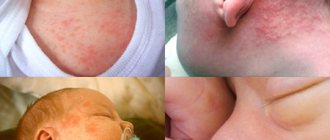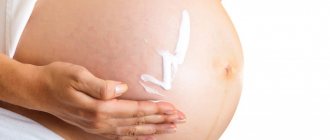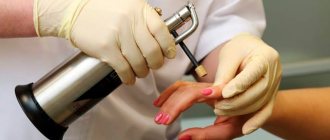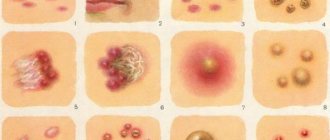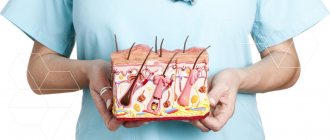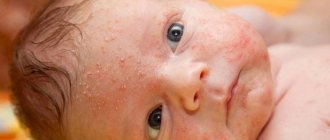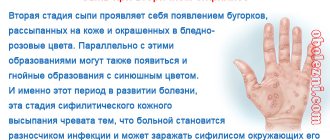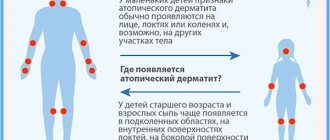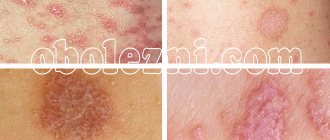How does a skin rash from coronavirus appear? The reported cases are only from observational studies, so it is not clear whether they are a symptom of COVID-19 or something else, such as a reaction to medications. However, WHO lists skin rash as a common symptom of coronavirus. It is also unclear how widespread the rash is. A Chinese study in February noted its presence in only 0.2% of more than 1,000 COVID-19 patients. At the same time, a smaller Italian study, published a month later, noted the prevalence of this symptom at 20.4%. The reasons why skin rashes from coronavirus appear have not been established. However, this is not at all uncommon among the symptoms of viral infections.
Measles, chickenpox, and herpes are typical examples of diseases with a characteristic rash. This is all part of the overall inflammatory symptomatology, when the immune system fights infection within the skin cells. It's not surprising that some COVID-19 patients may experience similar skin reactions.
Frequent skin manifestations of COVID-19
The most common skin manifestation of the new coronavirus is erythematous-edematous lesions. These are spots of different diameters and various shades of red. They do not itch, but the affected skin feels warm or even hot to the touch.
“Pink” rashes are scaly, oval-shaped spots that are most often located on the sides of the body and can cause discomfort due to itching.
Skin manifestations are not random: many of them are characteristic of a certain age group of patients or the severity of the disease.
Severe COVID-19
Acro-ischemia affects the fingertips, balls of the feet, or the skin of the heel area. Severe COVID-19 can lead to hypercoagulability—excessive thickening of the blood. It passes through blood vessels with difficulty, especially small ones - capillaries and venules, which leads to their damage, stagnation of blood and the formation of blood clots - thrombi.
The most severe and complex patients are those who, in addition to the tips of the phalanges, have a bluish coloration of the skin and mucous membranes (so-called cyanosis).
A rash similar to urticaria (urticarial rash) may appear earlier than the “classic” symptoms of coronavirus in the form of cough and fever. In children, urticaria appeared in 19% of cases of the total number of people infected with coronavirus and was associated with a more severe course of the disease than in other peers. But not every urticarial rash is a manifestation of COVID-19. In this case, the virus may be indicated by an elevated temperature, which is not typical for normal urticaria.
The most common rash seen in patients with the new coronavirus is maculopapular or maculopapular rash. It lasts about nine days from onset and primarily affects the thighs, forearms and shoulders.
Moderate severity of COVID-19
Researchers associate a rash resembling chickenpox with intermediate severity of the coronavirus. Most often, this symptom manifests itself in middle-aged patients.
As with chickenpox, the rash consists of small, identical blisters that cover the skin of the body. But true chickenpox and similar viral exanthema appear only after contact with someone who is already infected with these infections.
In the case of COVID-19, this rash lasts about ten days and disappears along with other symptoms, and sometimes even before them.
Mild form of COVID-19
Rashes on the fingers and toes, similar to frostbite, may appear with mild cases of coronavirus in children or young people. The average age of patients with frostbite-type rashes is 14 years. Doctors found this manifestation in 25 patients in Spain and 11 children in northern Italy. They had neither typical coronavirus symptoms nor objective causes of frostbite, and the test result for COVID-19 was positive.
When a frostbite-type rash occurs, bright red spots with a pink-violet tint appear above the surface of the skin. The affected areas, as a rule, are located asymmetrically, and after recovery, the symptoms go away without any treatment, leaving no scars.
The rash with petechiae, small pinpoint hemorrhages, as with the purple rash, did not affect the skin of the palms and soles, and there was no manifestation on the oral mucosa. This symptom does not always indicate coronavirus; it can also be caused by other infectious diseases or a reaction to medications. Biochemical blood tests and virological studies will help distinguish them.
Of the 27 children with mild disease, two developed a targetoid (target or ring) lesion resembling erythema multiforme. In this case, the round spots have a red center with a vesicle, resembling a target. These rashes can be grouped together. This symptomatology is typical for herpes simplex, but none of the patients suffered from it.
Relevant: How to distinguish influenza from acute respiratory infections and acute respiratory viral infections: comparative table, symptoms and features
In targetoid lesions, there are three color zones: a dark center with a blister or crust, a pale pink raised surface due to swelling around it, and a bright red outer ring. Targetoid lesions appear on any part of the body, including mucous membranes such as the lips.
Cutaneous manifestations have received increasing attention during the COVID-19 pandemic as they may be useful for early diagnosis, especially in children and the elderly.
If you notice a rash on yourself or your child, remember if you have been in contact with people with chickenpox or other infections with a characteristic rash. Could this be a manifestation of an allergy to food, cosmetics or cleaning products? If not, immediately contact a dermatologist who will accurately diagnose and prescribe treatment.
Features of viral exanthema in children
Viral exanthema in children is a disease characterized by rashes that appear on the child’s skin and evenly cover the entire body. It occurs frequently both in babies of the first year of life and in older children.
- measles virus;
- herpes virus;
- adenovirus;
- chickenpox, etc.
As a rule, the symptoms of exanthema are the same, with the exception of cases of measles or chickenpox.
During the course of these diseases, exanthema manifests itself specifically. In this case, complex therapy is used, which is aimed at getting rid of not only the disease, but also exanthema.
Exanthema of the viral and allergic types are similar in symptoms, so it is very important to recognize in time which pathology a specific type of rash on the baby’s skin belongs to. Improper treatment of exanthema is fraught with complications
General clinical picture
Viral exanthema in children is characterized by an increase in temperature, which usually lasts for 4-5 days. The rash at this time may become more intense under the influence of various factors: bright sunlight, hot water, emotional stress, etc.
It is important to protect the child from such phenomena so as not to worsen the situation. In newborns, the pulsation of the fontanel may become more frequent
Exanthema, which occurs against the background of infection, is accompanied by an increase in regional lymph nodes. It is provoked by the following infections:
In newborns, the pulsation of the fontanel may become more frequent. Exanthema, which occurs against the background of infection, is accompanied by an increase in regional lymph nodes. It is provoked by the following infections:
- in winter, as a rule, these are rhinovirus diseases, influenza virus and adenoviruses;
- in summer the causative agent is often an enterovirus;
- Herpes infections can be detected at any time of the year.
Symptoms depending on the type of virus
Symptoms of viral exanthema in children vary, depending on the type of infection.
The main symptoms are presented in the table.
Where is it more common and on what day do rashes appear due to coronavirus infection?
Analysis of the situation allowed doctors to identify typical locations of coronavirus rashes.
Belly, back, chest
The most common localization of rashes with COVID-19 is on the anterior surface of the body: chest, abdomen. Less commonly, the rash appears on the back. The primary element of the rash is a vesicle filled with serous or mixed with pus and blood contents, in second place are nodules. Any rash is accompanied by itching. There is a virus inside the bubbles.
Limbs
Rashes due to coronavirus infection affect the feet, and changes in the toes can even be attributed to specific manifestations of the virus - covid toes. They resemble frostbite with a bluish tint and necrosis of the nails. But despite the apparent severity of the manifestations, the symptoms are reversible and disappear without a trace after recovery. On the hands the picture is similar, but occurs less frequently.
Head, face
During coronavirus, these zones are not independently involved in the pathological process. But the rash can spread from the chest to the neck, scalp, forehead and cheeks.
Mouth, nasopharynx
It is surprising that despite the infection of the nasopharynx by the virus, there is never a rash in it. Apparently, defense mechanisms are triggered, forcing the virus to move on.
Types of rash due to coronavirus
Last week in the British Journal of Dermatology, a group of Spanish researchers described skin rashes associated with coronavirus. The analysis was based on a sample of 375 patients with COVID-19.
In total, researchers counted 5 types of coronavirus rashes
Rash on the arms or legs that resembles frostbite
Was recorded in approximately 19% of cases. Patients often complained of itching and/or pain when touched. Frost rash primarily affected young patients and was associated with a mild course of the disease.
It appeared, as a rule, later than the main symptoms and lasted an average of 12 days.
Blisters
Tiny blisters of the same shape were found on the back and abdomen in some patients, and on the arms or legs in others (a total of 9% of cases)
First of all, middle-aged patients suffered from them. As a rule, such a rash appeared earlier than other symptoms of coronavirus and was accompanied by severe itching. Lasted on average about 10 days.
Hives
The rash, similar in shape to hives, is a cluster of small itchy bumps on the skin that are reddish or whitish in color.
In most patients with coronavirus, such a rash developed throughout the body, however, in some it was localized on the palms of the hands. Lasted on average about a week and was associated with more severe cases of COVID-19. The total share is 19% of all cases.
Maculopapular rash
Several reddish bumps on a flat red patch of skin. Sometimes this rash appeared simultaneously with other symptoms of coronavirus, sometimes preceded them, was associated with a severe course of the disease and lasted on average about 9 days
Among all the described cases, this is the most common rash associated with coronavirus (47% of cases).
Papular rash
Most often, patients experience a rash in the form of small red papules. They are observed in 47% of patients with skin manifestations.
Such rashes are diagnosed in patients with severe disease and disappear on average within 8 days.
Redness on the skin
Younger patients also experienced redness of the skin and ulcers on the fingers. Such manifestations last about 13 days.
Urticarial rashes
Among patients with skin rashes, 18% of cases were diagnosed with a rash with urticaria-like eruptions. The itching is pronounced.
Vesicular rash
In more rare cases, a vesicular rash that looks like small blisters may appear. In 70% it causes itching.
Livedo (also known as necrosis)
A sign of poor blood supply and tissue death is a reticulated purple pattern on the skin called livedo, or reticular asphyxia. Found in elderly patients in serious condition. There were a total of six cases of this rash in the study.
Maculopapular rash
It looks like small red bumps. In some cases, it may appear along with other common symptoms. Their duration is 8-10 days. It is the most dangerous and common type of rash due to coronavirus (48%).
Rash on extremities similar to frostbite
The appearance of a rash on the legs and arms was observed in approximately 20% of cases. Patients often complained of itching and painful sensations when touched. In most cases, such a rash appears in young people who experience a mild form of the disease.
The rash usually appears later than other common symptoms and lasts about 2 weeks.
Rash in the mouth
A group of scientists from Spain conducted and published the results of their own study, which involved 22 people infected with Covid.
Relevant: Healing suppositories for the rectum: names of drugs
The results showed that most of them had a small, reddish rash called enanthema in their mouths. Scientists say that such a rash on the oral mucosa is one of the main signs of a viral infection, which appears a couple of days before other symptoms.
Symptoms and types of exanthema
It all starts with a sudden increase in body temperature (fever), the lymph nodes in the neck become inflamed, and in rare cases, diarrhea occurs. If a child has exanthema, he becomes lethargic, moody, and eats poorly. As a rule, parents, and sometimes even attending physicians, blame everything on teeth being cut.
The rash does not appear immediately, but after the fever lasts three or four days, then the temperature drops and a rash appears. It can occur throughout the body, or maybe in specific areas. The rash does not itch, does not bother, has the form of small spots that become invisible when pressed. But as soon as you release the pressure, the rash appears again.
The rash on the skin lasts for 2-3 days, then everything goes away. Exanthema is considered a non-contagious disease. But still, at the time of illness, it is better to isolate the child from other children.
Exanthema roseola
Exanthema is a measles-like rash observed in many infectious diseases, although it can develop in other cases: allergies, insect bites, contact with chemical products, etc. However, most often exanthema roseola flares up during infectious diseases. It could be scarlet fever, measles, chickenpox, rubella.
Roseola is called a formation on the skin in the form of a small speck of 2 or 5 mm, round in shape, red, pink. The formation of this spot occurs due to the expansion of the vessels of the papillary layer of the skin. It is quite easy to determine that it is roseola; you just need to press on the rash or stretch the skin and the spots will become invisible until the skin returns to its normal state. Exanthema consisting of roseola is called roseola rash.
Sudden exanthema
Sudden exanthema is a viral disease that begins suddenly and lasts a very short time. This disease is provoked by herpes virus 6, and in very rare cases, virus 7.
Is this disease contagious? Yes, it is transmitted both through tactile contact with carriers of the infection and through the environment (airborne droplets). The incubation period can last up to 9-10 days. Symptoms vary depending on age. In young children there is always a rash; in older children the disease can occur without a rash. One thing they all have in common is high fever and diarrhea.
The temperature lasts from 3 to 5 days. The disease goes away on its own without any drug intervention.
Of course, there are exceptions in the form of complicated exanthema, which is possible with low immunity.
Viral exanthema
A skin rash of viral etiology is called an exanthema. Mostly viral exanthems appear as a result of enteroviruses, as well as measles, chicken pox, and herpes simplex.
Scientists have proven that all viruses in this disease are located in the skin area. On the skin, formations appear in the form of papules, spots, blisters, and also in the form of red circles. Viral exanthema is treated depending on the virus that caused it. Without treatment it goes away on its own.
Vesicular exanthema
Vesicular exanthema is an acute viral disease of pigs. It usually begins with an increase in temperature and the appearance of vesicles—liquid-filled bubbles—on the mucous membranes. Almost all pigs of various breeds and ages are susceptible to the disease.
The disease is transmitted from sick animals to healthy ones through food. The symptoms are as follows: loss of appetite, drooling, fever, rashes on the patch, tongue, and on the surface of the skin. Rashes on the legs can cause lameness.
Vesicular exanthema can occur as a result of pneumonia or intestinal infections.
If the rashes are profuse or the pig is in contact with the rest of the livestock, treatment with an astringent disinfectant solution cannot be avoided.
Presence of signs in children
For the first time, rashes began to be observed in children. Moreover, before this, they had not been diagnosed with coronavirus infection. Visually, the pathology looked like this:
- areas of redness on the fingers of the lower extremities;
- the affected area swells slightly;
- there is no itching.
More often, the symptom is detected in asymptomatic carriers. When a symptom is detected, a test for covid-19 is done. Antibodies to pathogenic microorganisms are determined. That is, the child became infected from the people around him, but he did not suffer from dyspeptic disorders, bronchitis, or pneumonia.
If a family member has contracted the infection, children may not have frequent symptoms, but it is recommended to check their skin periodically.
Doctors associate the emerging symptom with the effect of the virus on blood vessels. A spasm of the endothelium occurs, so blood flows worse to the affected area. The toes are often affected because they are located more distal to the heart. The condition does not require specific treatment; it goes away on its own. But it is necessary to monitor the child’s well-being in order to prevent complications on the cardiovascular system due to repeated spasms or the formation of blood clots.
Treatment
In general, viral exanthema in children does not require targeted treatment. Therapy is symptomatic and is aimed at:
- Reducing temperature, eliminating symptoms of intoxication. For this purpose, drugs with ibuprofen and paracetamol in age-specific dosages are usually used.
- Reduced itching sensations. For this purpose, local and systemic antihistamines are used. Loratadine, Cetrin, Zyrtec, etc. are usually taken orally in the form of tablets. Children are most often recommended to take Zodak, Claritin or Erius syrups.
- Prevention of bacterial complications. To do this, the elements of the rash are treated with antiseptics, for example, the well-known brilliant green or Fukortsin.
- General strengthening of the body. Your doctor may prescribe the use of multivitamin medications. Antiviral drugs or immunostimulants are occasionally used (mainly if there is a risk of complications).
All medications have certain contraindications and can cause side effects. They must be used only in accordance with the instructions.
When can you not treat?
Medicines in the treatment of viral exanthems are not needed in 100% of cases. You can do without them if the patient:
- Does not suffer from a strong increase in temperature (temperature up to 38.5 ° C can be maintained if there are no direct medical indications for this).
- Doesn't feel too bad.
- He is recovering quickly.
When viral exanthema develops in children, parents must adhere to the basic rules of caring for a sick child:
- Regularly ventilate the room and carry out wet cleaning.
- Give your baby plenty of liquid (plain water, juices, teas, fruit drinks, rosehip decoction, compotes, etc.).
- Do not force feed the baby. If you have an appetite, include easily digestible food in your menu.
In any case, for successful recovery from viral exanthema, it is important to follow the doctor’s recommendations. If the patient’s condition suddenly worsens, it is necessary to promptly seek medical help.
Rash is a sign of another pathology
Skin rashes do not always mean the presence of a coronavirus infection. To determine the exact cause, laboratory tests are recommended. There are the following diseases and conditions in which similar forms of rash may appear:
- chicken pox;
- measles;
- psoriasis;
- allergic reaction;
- skin mite, fungus, bacterial infection;
- insect bites.
To confirm the diagnosis, a series of laboratory tests are prescribed. Among them, a skin test and blood donation for the presence of allergens, bacteriological culture, microscopy of scrapings from the skin or mucous membranes are necessarily used. A general blood and urine test is also prescribed to determine the condition of the body.
If the doctor suspects covid-19, you can undergo a laboratory test. But the sample is taken not from the area of the rash, but from the nasopharynx. The smear is sent for PCR, which detects the presence or absence of infection. Blood is also taken to determine whether the patient has antibodies to the pathogen in the blood.
What are the causes of the pathology?
The etiology of viral exanthema is quite diverse. It is believed that skin rashes occur due to the influence of the following pathogenic mechanisms on the body:
- The tissue is affected by viruses that spread along the bloodstream.
This means that the disease is accompanied by enteroviruses, herpes type 1, and so on. - A skin rash with viral exanthema appears due to pathological reactions between immune cells and the infectious agent. It is according to this principle that exanthema appears with rubella.
The causes of viral exanthema in adults and children, as a rule, are the following:
- The appearance of measles, rubella or herpes type six, which causes roseola.
- The presence of Epstein-Barr virus, cytomegalovirus or enteroviruses.
- The emergence of herpes virus type seven.
In this case, doctors usually diagnose sudden exanthema. - The emergence of herpes virus type 1. In this case, this disease accompanies shingles or chickenpox.
- The presence of Coxsackie virus when viral pemphigus occurs.
- Presence of adenoviruses. In this case, a visculous rash appears on the skin.
- Allergic exanthema may occur under the influence of allergens.
Coronavirus rash in humans 2021: what it looks like, does it itch?
According to dermatologists who studied the course of a new infection caused by the SARS-CoV2 coronavirus in 2021, 5 types of rash were identified. It looks like:
- spots (maculopapular, including petechial in the form of small points of hemorrhages) in 47%;
- similar to urticaria (urticarial) – 19%;
- red areas (erythematous) according to the type of frostbite – 19%;
- vesicles (small vesicular) – 9%;
- enhanced vascular pattern (livedo) – 6%.
The elements may not be accompanied by sensations, but most often patients note that the spots and blisters itch, and there may also be pain in the affected areas. All these skin changes may resemble the course of other diseases, so doctors began to talk about dermatological (skin) coronavirus masks: angiitis (inflammation of blood vessels), false frostbite, rashes similar to chicken pox, pityriasis rosea, measles, urticaria.
Angiitis
Skin angiitis due to coronavirus is an infectious-allergic rash due to damage to blood vessels in the skin. Their walls become inflamed due to the attachment of immune complexes (virus + antibody). The elements are represented by red spots and are located on the legs, thighs and feet, less often found on the hand, forearm and buttocks. In severe cases of coronavirus, the rash is spread throughout the body. This form of skin manifestations is more common in older patients.
Angiitis is combined with the development of pneumonia and can become a sign of life-threatening complications (distress syndrome, cytokine storm), since extensive pneumonia and damage to skin vessels are associated with an excessive immune response of the body to a viral infection. As the rash progresses, the areas change appearance - from small red spots (hemorrhagic, petechial rash) they can turn into zones of destruction (necrosis) and become covered with dark crusts.
As you recover, the elements of the rash gradually disappear, leaving dark spots on the skin.
Pseudo-frostbite of the feet
Frostbite-like areas (acrodermatitis) have been described in children, adolescents, and young adults, but are less common in middle-aged and elderly patients. Appear on the heels, lower surface of the toes, and hands. Typically, in patients with acrodermatitis, coronavirus occurs in a mild form, sometimes without fever, cough, or sore throat. The rash areas may appear as spots or red lumps.
Dermatologists propose to consider this type of skin manifestations as a typical lesion due to coronavirus, since during a cellular study of elements and lung tissue, the same changes were found in them.
Blisters that look like chickenpox
Blistering rashes are located on the skin of the torso; they appear almost simultaneously with the main symptoms of coronavirus (fever, weakness, cough), but more often they lag behind them by 2-3 days. They may not give any sensations, or the patient complains of tingling of the skin.
Since most patients have not yet started drug therapy during the rash, doctors suggest considering a vesicular (fine-bubble) rash as a consequence of the coronavirus infection itself.
Many patients note that the rash occurs against the background of severe sweating. A fungal disease – folliculitis – gives very similar symptoms. It can occur latently for a long time, and manifests itself with increased skin moisture and in patients with a weak immune system, as well as during treatment with antibiotics. Therefore, it is possible that coronavirus and its treatment gives impetus to its exacerbation. With treatment, the rashes disappear without a trace.
Relevant: How and with what to treat your hands during coronavirus
False urticaria
Elements of rashes similar to urticaria were often present the day before the temperature rose or appeared for the first time on the day of the first manifestations of coronavirus. Doctors consider the specific location of the rash to be predominantly localized on the hands and feet, sometimes they are on the torso. The spots have a bright pink color, relief and uneven outlines, covered with blisters, often painful and itchy. The surrounding skin is swollen and red.
Gibert's pseudolichen rosea
With some viral infections (influenza, parainfluenza, other acute respiratory viral infections), pink spots of zoster may appear for the first time, but with the COVID-19 coronavirus, a unique form of the disease is noted. It is distinguished by the absence of a primary (large) maternal plaque with a red scaly rim and an internal scaly surface.
The spots are mainly located on the lateral surfaces of the body, located along the skin lines. Over the course of 3-5 days, the elements of the rash increase in size, but extremely rarely merge. Their center becomes yellowish and peels off, but the rim remains for a long time. During the recovery period from coronavirus, new rashes do not appear in a patient, and old ones fade. Gradually the skin acquires a normal color.
Measles-like rash
The first description of a measles-like rash was in an Italian patient in his 20s who was hospitalized with coronavirus pneumonia. The rash was accompanied by fever and pain, but there was no itching. The elements looked like ring-shaped spots with seals in the center. They were located throughout the body, but the face and mucous membranes remained unaffected.
Later, French doctors observed a 40-year-old patient in whom this symptom was the only one, and the fever lasted only 2 days. Spanish doctors have described a variant of the course of coronavirus infection, in which a measles-like rash appeared only on the 6th day of illness and was combined with high fever, dry cough, weakness and muscle pain. In all patients, after 4 days peeling appeared and the rash disappeared.
Drug allergy
For coronavirus, antimalarial, antiviral and antibacterial drugs are used, and in severe cases only one drug is rarely prescribed. Cases of side effects of medications in the form of a rash have been reported in patients. It looked like reddish spots with a bluish tint, merging with each other.
Doctors reported several forms of drug intolerance - rashes were all over the body or localized only under the arms, in the area of the groin folds. Most patients received Plaquenil and Azithromycin, Ceftriaxone.
Livedo reticularis
Livedo is a pattern on the skin, it is associated with visible small vessels that are normally hidden. Along the way, pinpoint red or blue rashes may also appear. Such signs are characteristic of circulatory disorders, blood thickening and microthrombosis of capillaries. Most cases of livedo were found in elderly patients with severe coronavirus pneumonia and septic complications (blood poisoning).
How does it go?
Viral exanthema in children most often disappears without a trace. The time it takes for the rash to disappear may vary:
- With roseola, the rash disappears two to three days after its appearance.
- With measles-like viral exanthema, the skin becomes clear within 1–2 days after the rash.
- With roseoloform viral exanthema, the rash disappears in 1–4 days.
- Viral pemphigus completely disappears in about 1 - 1.5 weeks.
- Erythema infectiosum disappears from the skin in 1–3 days.
- The rash with infectious mononucleosis can last up to 1.5 weeks.
- Measles rashes begin to disappear approximately from the fourth day after their appearance, and the rash disappears in the reverse order from its appearance. The skin usually clears completely within 1–1.5 weeks (sometimes earlier).
- With rubella, the rash usually goes away completely in just 3-4 days.
- Blisters for chickenpox stop appearing 5–8 days after the onset of the disease, after which they gradually disappear. Typically this process takes up to 1.5 weeks.
The recovery period for different types of viral exanthema largely depends on the individual characteristics of the patient and the severity of the disease.
Diagnostics
If dermatological disorders occur, the risk of coronavirus infection must be assessed. If contact with an infected person was possible in the next 14 days, it is recommended to consult a doctor. To reduce the likelihood of infection in medical institutions, it is recommended to consult a dermatologist or other doctor online if there is no significant deterioration in your health. Using high-quality photographs, specialists will be able to conduct differential diagnostics. If necessary, the patient is referred for a more detailed examination, including dermatoscopy.
How to distinguish it from other skin diseases?
Skin rashes during coronavirus infection are not considered specific signs, so it is impossible to distinguish this dermatological disorder from other pathologies by appearance alone. Since discoloration of the skin tissue does not appear as often with COVID19, small red spots are more likely to indicate dermatitis, an allergic reaction to drugs, or irritation due to the use of hygiene products.
Differential diagnosis is carried out by specialized doctors. It is recommended to provide the doctor with a photo or contact the medical center yourself.
Other symptoms
- Increased body temperature, fever.
- Itching and soreness of the skin.
- Cough, breathing problems.
- Weakness and dizziness.
- Burning sensation in the chest area.
- A sore throat.
Common type
If, in addition to dermatological disorders, the above complaints occur, you need to call a doctor at home for an examination. If you experience severe shortness of breath, prolonged fever, loss of consciousness, or bluish skin, seek immediate medical attention.

